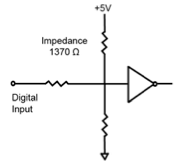A common application for Yokogawa Corporation of America PROPLUS series is for monitoring & alarming. In these applications, the meter is not used as a primary controller, but a safety device. As such, Yokogawa added another safety feature called Interlock Relay. This feature allows a process to use very low input signals or dry contacts to signal the PROPLUS that an event occurred that should cause one or more "normally opened" (N/O) assigned relay contacts to "open". While its main purpose is to remove power from a final control element in the event of a safety violation, it is likely that this feature will be used for many more applications as its configuration is very versatile.
Any, or all, of up to 8 digital inputs can cause any of the four main relays to energize with a closed contact or 5 volt signal present at the assigned digital input(s). This feature is designed to be a fail-safe circuit. This means that the interlock relay will "de-energize" with a failure (open digital input loop, loss of digital input signal, loss of power to the meter, etc.). This is called a "Normally Energized Mode" or fail-safe. The relay indicator will flash when the interlock relay is "de-energized" alerting the operator of the safety violation.
The most common configuration of this would be to have a loop of safety contacts in series. The wiring and contacts would carry no more than 5 volts at a low 3.5 mA (approx. - see Figure 1). This loop would be connected to a single logic input which in turn would control a single interlock relay (see Figure 2 below).
 |
 |
| Figure 1 | Figure 2 |
However, the "load" may be 3-phase. In that case, it may be preferable to have one safety input loop, but to trigger two, or even three, interlock relays. Then again, instead of three phase power, one might want to shut down multiple loads. So there is significant flexibility.
The reason for the multi-input/output capability is to provide the capability of multi-action depending upon the violation type or zone. For example, a user may want to open or close a valve when a first level limit switch is opened, and shut-down a pump when a second level limit switch opens in any of 2 tanks. In this case, one interlock relay would be wired to the valve, while the other would be wired to the pump (see Figure 3 below).

Figure 3
To configure an interlock relay for the above example, we would follow the following steps.
- Under Setup/Relay 1 the Action (Act 1) would be set to off (OFF).
- Under Setup/Relay 2 the Action (Act 2) would be set to off (OFF).
- In the Advanced menu under User (uSEr) set D1 input (D1 I) to Force On 1 (F On 1)
- In the Advanced menu under User (uSEr) set D2 input (D1 2) to Force On 2 (F On 2)
If a different digital input & relay output is used for each safety switch, then the user has the advantage of identifying the violating input by observing which relay indicator is flashing on the front panel. Since the PROVU offers up to 8 relays, there is plenty of capability.
Please refer to the manual when configuring interlock relays.
Remember, ultimately, it is up to the system designer to provide for the safe operation of a process. But certainly, no single event should make the difference between a safe situation and a catastrophe. Interlock relays can provide another level of personnel and equipment safety if configured correctly.
Disclaimer
The information contained in this document is subject to change without notice. Yokogawa Corporation of America makes no representations or warranties with respect to the contents hereof; and specifically disclaims any implied warranties of merchantability or fitness for a particular purpose.
Industries
-
Water & Wastewater
All water, regardless of its source, has value. However, with water resources being finite, a focus on "One Water" is necessary to maximize every drop within the water system, ensuring a stable supply of clean and safe water. As we consider current and future needs, planning and implementation are critical for long-term resilience and reliability, meeting both community and ecosystem demands. Yokogawa believes water is a human right for all. Thus, contributing to a sustainable water cycle is one of our Sustainable Development Goals (SDGs).
Related Products & Solutions
-
YPP6200 Analog Input Flow Rate/Totalizer
- YPP6200 Flow Rate Indicator/Totalizer
- Displays flow rate and total from a flowmeter with analog output
- 6 digit, dual-line display
- Program for a wide variety of display configurations
-
YPP6300 Pulse Input Flow Rate/Totalizer
The YPP6300 meter is specifically designed for displaying flow rate and total from a pulsed input provided by an open collector, NPN, PNP, TTL, switch contact, sine wave, or square wave output flow meter. The YPP6300 is particularly well-suited for flow applications because its six-digit, dual-line display can be programmed for a wide variety of display configurations.
Have Questions?
Contact a Yokogawa Expert to learn how we can help you solve your challenges.